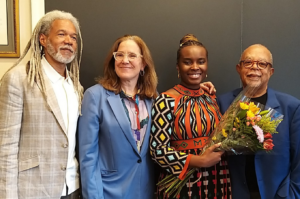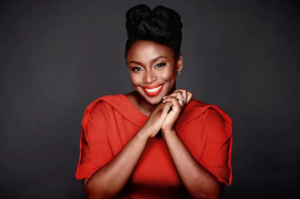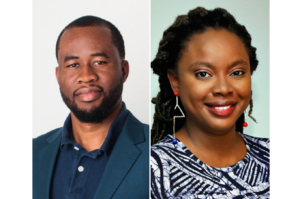
Akwaeke Emezi, most recently photographed for Vogue ahead of the release of her debut novel Freshwater, has come out as a non-binary transgender person—she is not a man in a woman’s body, she is just not a woman. She realised this five years ago and has since undergone surgeries to remove her uterus.
“It’s easier when I’m alone. My friends and family know I’m not a woman — I’ve told them — but some continue to think of me as one anyway,” she writes in a new, intimate essay for New York Magazine‘s The Cut. “I ignore it because sometimes it’s easier to not fight, to accept the isolation of being unseen as a safe place. I exist separate from the inaccurate concept of gender as a binary; without the stricture of those categories, I don’t even have to think about my gender. Alone, there’s just me, and I see myself clearly.”
But her case is a peculiar one, as she is also an ogbanje—a term she has used for herself for years now. An ogbanje, in Igbo cosmology, is a being born into the world but who constantly leaves to rejoin the spirit world, dying as many times as they are born, leaving their families traumatized. To keep them from leaving, their dead baby bodies are marked, tortured. Or, in cases when they live up to adolescence, are coerced to reveal their secret ties to their fellow spirits, which are then severed in elaborate rituals: You will recall this ritual from Things Fall Apart, in which Okonkwo’s daughter Ezinma is one.
These two definitive identities—one spiritual, the other biological and psychological—are what Akwaeke Emezi admirably tries to tie together in the essay. It’s titled “Transition.”
(It is important to note that Freshwater, her forthcoming novel about a woman with fractured selves competing within her, is rooted in her own experiences.)
Read the essay below.
*
The robot was called a da Vinci.
It was delicate, precise, inserted through my navel to slice my uterus and fallopian tubes into small unimportant pieces, which were then suctioned out of my body. The procedure had a technical name that filled my mouth — a robotic-assisted subtotal hysterectomy with a bilateral salpingectomy. I had to repeat this about seven times on the day of my surgery, as nurses came in with forms clarifying that I knew what I was getting, but I didn’t mind. I’d waited years for this surgery. In another life, I’d trained to be a surgeon myself, dissecting cadavers and cutting through layers of dermis and fascia and muscle with a ten-blade. But in this one, I was 28 and cold, my numb skin wrapped in a hospital gown as nurses draped warmed blankets over me. Still, anticipation rang clear chimes. I couldn’t wait for when they’d wheel me out of that operating room, finally sterile.
It had been five years since I figured out I was transgender, after falling into a vibrant queer scene in Brooklyn that showed me so many more ways to be than I’d ever known. I moved there from Massachusetts, leaving behind scalpels and skinned horses dangling from a warehouse ceiling at a veterinary school, coming to reddened cabaret nights and play parties and a brief stint as a drag king. With a new world wrapping around me, the discomfort that had been spreading sour and wrong through my body for ages finally had a name — gender dysphoria. It came with a sort of relief: If I knew what it was, I knew what I could do about it.
My best friend Rachel flew into upstate New York for the hysterectomy. After the excision, she unfolded a cot in my hospital room while I ordered waffles from room service. When the nurses came in, they tried to get me to stand up, but the pain was a riptide dragging me under. I swayed, nearly collapsing, so they eased me back into bed and upped my pain meds. I caught my breath as Rachel and I exchanged alarmed looks, her hand warm around mine.
“I didn’t think it would be this bad,” I managed to say.
“Me either,” she replied.
The nurse gave us a brief but incredulous look. “You got an entire organ removed from your body,” she pointed out. “It’s kind of a major surgery.”
I made it out of bed a few hours later, walking in slow motion around the hospital floor with my IV stand rolling beside me, my palm scraping against the walls and the nurse at my elbow. The next day, Rachel drove me home to my attic apartment. Most of my early recovery was spent there, in a wingback recliner the color of wet moss. It had a wooden handle on the side that opened the back hinge and made the foothold pop up with a creaky jerk, stretching the chair out. I slept in it for a week because I had difficulty standing up or bending into narrow angles, and my bed was too close to the floor. I was full of stitches and hydrocodone, and my guts had been rearranged.
It wasn’t my first mutilation, but it was one of my best.
An ogbanje is an Igbo spirit that’s born into a human body, a kind of malevolent trickster, whose goal is to torment the human mother by dying unexpectedly only to return in the next child and do it all over again. They come and go. They are never really here — if you are a thing that was born to die, you are a dead thing even while you live. Igbo ontology explains that everyone is in a cycle of reincarnation anyway — you are your ancestor, you will become an ancestor, the loop will keep looping within the lineage. Ogbanje, however, are intruders in this cycle, unwelcome deviations. They do not come from the lineage; they come from nowhere. As such, it’s important for an ogbanje never to reproduce: if it did, it would contribute to the lineage, and when it died, its spirit would join those of the humans, participating in their reincarnation loop.
Removing a uterus is an efficient way to make sure this never happens.
While my gender had asserted itself in different ways since my childhood, one of its strongest features was always a violent aversion toward reproduction, toward having a body that was marked by its reproductive potential — a uterus to carry children, full breasts to feed them with. My first surgery was an outpatient procedure two years after I moved to Brooklyn, a breast reduction: some fat removed from my chest, some glands, some skin, nothing much. It required a letter from my therapist to prove that I was sane.
“I’ve never heard of anyone like this,” the surgeon told me.
He was an old white man who had performed many surgeries on trans patients, from breast augmentations to double mastectomies. “Male to female, female to male, fine. But this in-between thing?”
I ground my teeth into a smile and handed him my letter, along with printed images of the chest I wanted. It was one that felt right for me, one that wouldn’t move much, wouldn’t sway with pendulous wrongness or leave me gasping shallow breaths because my ribs were encased in the flattening black of a chest binder every day. I paid his office $10,000 skimmed from my student loans and tried not to be angry at the hoops I had to jump through. If I’d asked for an augmentation, it would’ve been fine, but wanting smaller breasts in the absence of back pain was considered ridiculous enough to require a therapist’s approval. During my post-op visit, the surgeon complained that he’d never had to spend as much time in consultation with a patient as he had with me. We’d spent maybe 30 minutes together over a few appointments.
My scars hypertrophied, leaving shiny brown keloids and flat glossy rivers on my chest. Sometimes, when I felt like I wasn’t trans enough, I’d look at them to remind myself that I’d chosen to modify my body and even though dysphoria and surgery aren’t prerequisites for being trans, the scars still served as a grounding reflection of my own certainty. I wasn’t sure then what I was transitioning my body to, but I was clear that the gender I’d been raised as was inaccurate — I’d never been a woman.
After that first surgery, my depression lifted significantly. It was a connection I hadn’t made before, how my dysphoria was affecting my mental health — the suicide attempt I’d survived just four months before the surgery. The choice to finally modify my body felt like a big deal in large part because other people treated it that way. Their alarm was almost infectious, but I was the one who had to live in this body; I was the one who suffered in it. The reduction was simply a necessary procedure, something that helped pull me away from wanting to die, something that made living a little easier.
Still, there was a deep sense of transgression about what I was doing that I couldn’t shake, especially as a Nigerian. It was too easy to tune into our communities and hear the voices heavy with disgust, saying that what I had done was disfiguring, that God had made me one way for a reason and I had no right to say or do otherwise, that I was mutilating myself. There was an ideal my body was supposed to conform to, and I was deviating from it by having surgery. I was rejecting it as a center and choosing something else: a world where the deviation itself was the ideal. I chose it readily. I’ve never minded being a mutilated thing.









I Don't Want To Own A Uterus Anymore | Adventures From the Bedrooms August 13, 2022 16:06
[…] take it out until one day, deep in research about sexual politics and queer theory I came across Akwaeke Emezi’s story on Figuring Out She Is Transgender. Their story was fascinating and has stuck with me since. An actual permanent solution to my […]